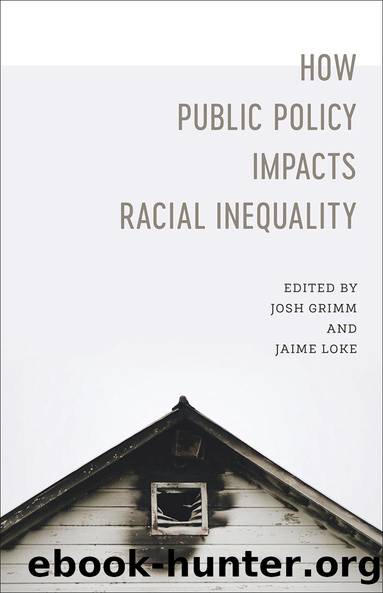How Public Policy Impacts Racial Inequality by Josh Grimm Jaime Loke Robert Mann

Author:Josh Grimm, Jaime Loke, Robert Mann [Josh Grimm, Jaime Loke, Robert Mann]
Language: eng
Format: epub
Tags: Nonfiction, Social & Cultural Studies, Political Science, Government, Public Policy, Social Science, Discrimination & Race Relations
ISBN: 9780807171691
Publisher: LSU Press
Published: 2019-05-08T04:00:00+00:00
CONCLUSION
Multiracial groups provide a case study for how race-conscious policies must evolve as we come to understand the complexity of the daily experience of racialization in the United States. Even this more complex understanding of how racialized experiences shape inequality remains incomplete; for example, we have largely discussed racialization processes in the United States as a whole, with little attention to the ways in which racialized experiences actually vary across the life course or across places. For example, multiracial youth and young adults are often treated as âexotic,â and there is great emphasis placed on their appearance and beauty, an emphasis that is often limited to the young. Similarly, groups are racialized differently in different regions of the country, with far more acceptance of multiracial identities in Hawaii than in the mainland United States, and with different beliefs about boundaries like the âone-drop ruleâ in the North than in the South. Texas is an unusual case because of its long history of a large and established Latinx community, its growing black community, and its placement at the boundary between the South and the Southwest, but these findings would undoubtedly vary across the country.
Despite its incomplete nature, however, this case study of experiences of multiracial groups in Texas points a way forward for designing new policy. If we design our race-conscious policies to incorporate multiple measures and understandings of race, rather than relying on a simple construct that assumes race is always obvious to all and falls neatly into simple, exclusive categories, we can design policies that can adequately address the variety of racialized experience today, and that are flexible enough to adapt to new experiences tomorrow. Directly asking applicants and respondents for the information we want (such as the types of discrimination they experience, for example, or how they are perceived by others) rather than assuming that self-identification maps directly and simply onto these experiences is a powerful corrective that would apply across many different types of groups, experiences, and social contexts.
Download
This site does not store any files on its server. We only index and link to content provided by other sites. Please contact the content providers to delete copyright contents if any and email us, we'll remove relevant links or contents immediately.
International Integration of the Brazilian Economy by Elias C. Grivoyannis(91629)
The Radium Girls by Kate Moore(11930)
Turbulence by E. J. Noyes(7942)
Nudge - Improving Decisions about Health, Wealth, and Happiness by Thaler Sunstein(7622)
The Black Swan by Nassim Nicholas Taleb(7016)
Rich Dad Poor Dad by Robert T. Kiyosaki(6413)
Pioneering Portfolio Management by David F. Swensen(6229)
Man-made Catastrophes and Risk Information Concealment by Dmitry Chernov & Didier Sornette(5924)
Zero to One by Peter Thiel(5691)
Secrecy World by Jake Bernstein(4652)
Millionaire: The Philanderer, Gambler, and Duelist Who Invented Modern Finance by Janet Gleeson(4384)
The Age of Surveillance Capitalism by Shoshana Zuboff(4214)
Skin in the Game by Nassim Nicholas Taleb(4165)
Bullshit Jobs by David Graeber(4101)
The Money Culture by Michael Lewis(4082)
Skin in the Game: Hidden Asymmetries in Daily Life by Nassim Nicholas Taleb(3935)
The Dhandho Investor by Mohnish Pabrai(3705)
The Wisdom of Finance by Mihir Desai(3658)
Blockchain Basics by Daniel Drescher(3511)
